Welcome to this delayed edition of This Writing Life: A. Outback Queensland Adventure. I’ve been trying to organise this post for a while but the first round of edits for THE COUNTRY GIRL landed while I was away and that meant it was straight down to business on my arrival home, with no time to spare for travelogues. Or house cleaning for that matter, but any excuse to get out of that.
Anyway, better late than never!
For those of you who missed my adventures on social media, in mid March Jim and I had to fly up to Townsville for some appointments. Because Murphy’s Law dictated that nothing matched up (actually, it was probably more our disorganisation that caused this but Murphy is so much easier to blame), we ended up with a few days to spare. This also coincided with my globe-trotting parents-in-law leaving their four-wheel-drive parked in Townsville.
Four-wheel-drive…
Queensland outback practically on the doorstep…
At a loose end…
Never look a gift horse and all that I say. So we pinched the car and hit the road.
If you ever get the chance to go driving around outback Queensland, I highly recommend you take it. As you’ll see from the following photos, we had a BALL!
To put things in perspective, this map shows where we headed to: Townsville, through Charters Towers and then out to WInton and surrounds.

From Townsville we headed out past Charters Towers and then down to Winton, approximately 600kms.
The drive out was fun. The humour in outback Australia can be as dry as the landscape, as demonstrated by this laugh outside of Charters Towers.

Grounded! The writing on the boat reads: Lake Wanted, Boat Grumpy. I’ve seen this a few times now and it never fails to crack me up.
There’s a tiny little town called Corfield, population 10, on the Winton to Hughenden road, which has nothing much more than a pub come shop, a couple of other buildings, and a bit of a camping ground. But each year they hold the “real” Corfield Cup, a play on Melbourne’s famous Caulfield Cup horse race, and the population swells to more than 1000.
Sounds right up my alley. One for the bucket list!

Corfield, Queensland. Home of the “real” Corfield Cup.
There’s a lot of flat country out there…

The seemingly endless mitchell grass downs that dominate the road to Winton.
Another tiny town was Prairie, population 50, and once a main horse change for Cobb and Co. coaches. The pub is a blast and a must-stop.
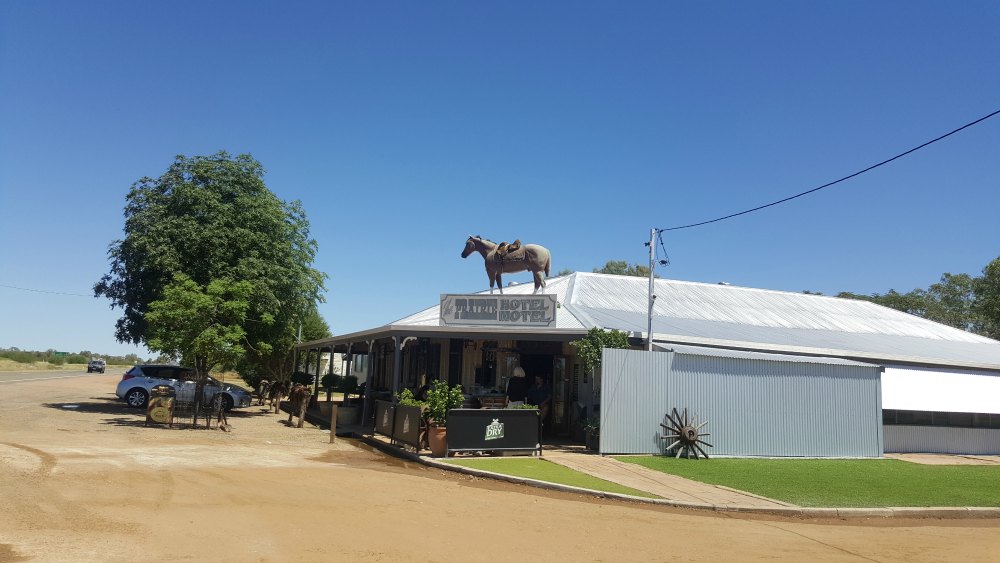
The Prairie Hotel, complete with horse on the roof, saddlery draping the front rails and very friendly locals.

Inside the Prairie Hotel. A treasure trove! There was even an old barber’s chair.
Deciding to make Winton our base and travel outwards from there, we booked a room at the North Gregory Hotel. First opening it doors in 1879, the hotel has been destroyed and rebuilt multiple times. This is the 4th North Gregory Hotel which opened in 1955 (and was owned by the local council!) and it’s a fantastic building.
There’s so much history in this hotel alone. It was the location of the first public performance of iconic song Waltzing Matilda in 1895. Lyndon Johnson, who would go on to become the 36th President of the United States, stayed here as a Navy Lt Commander after his plane crash landed at Carisbrooke Station in 1942. It was also where locals held secret meetings as they formed the airline Qantas.
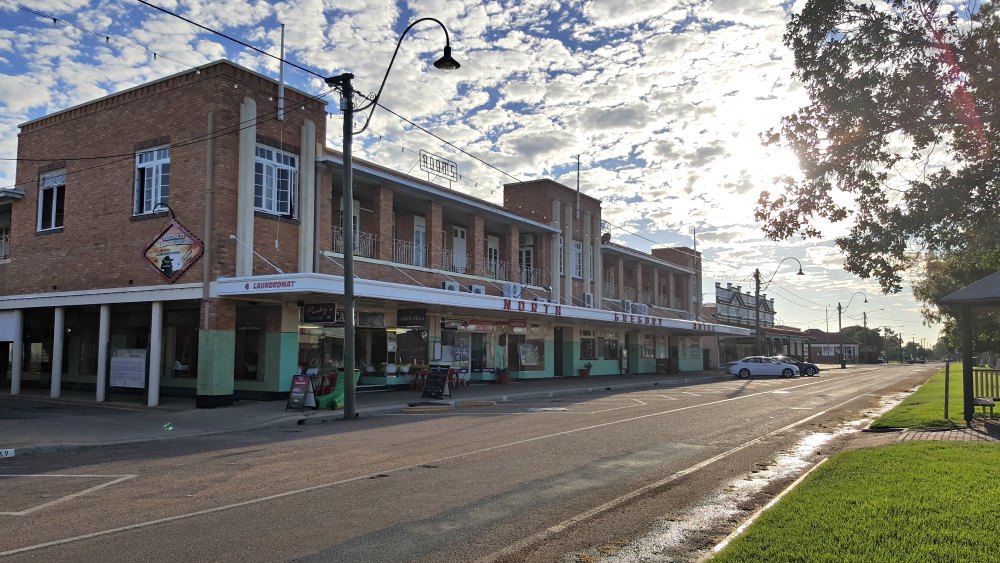
Such a great looking hotel, and a gorgeous morning for adventuring.
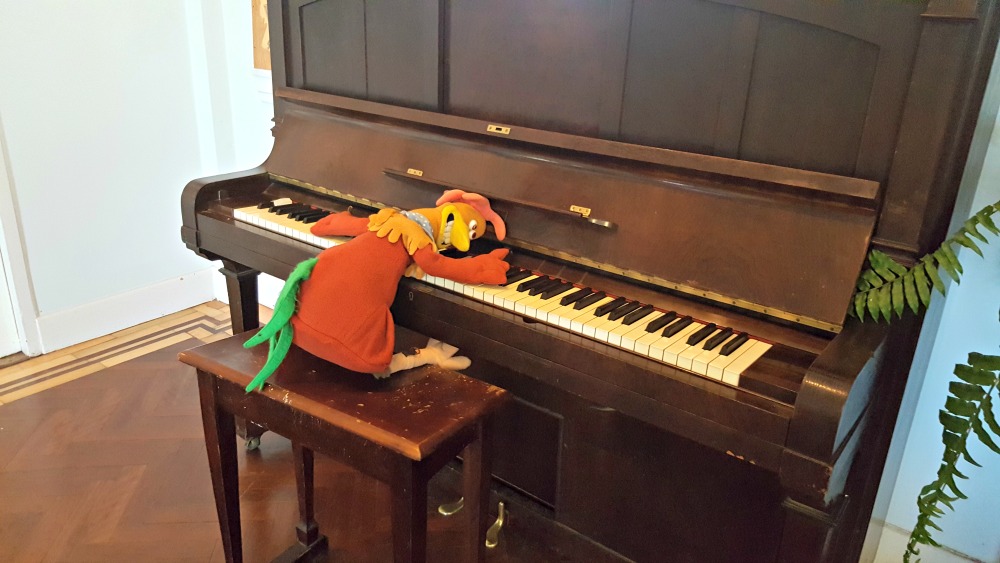
This made me smile each time I passed. Near the location of the first public performance of Waltzing Matilda.
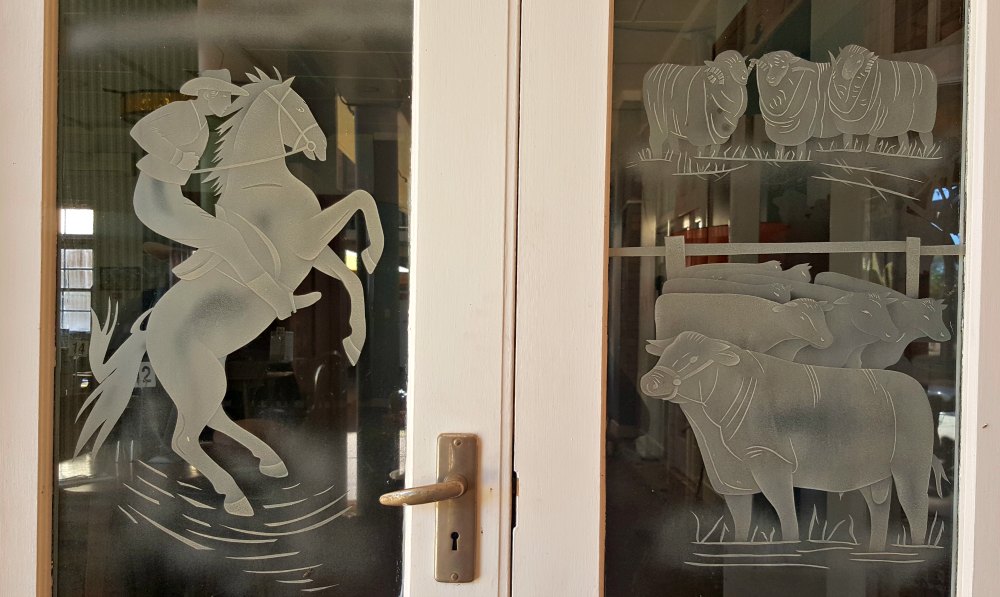
Artist Daphne Mayo (1895-1982) created these etched glass panels for the dining room at the North Gregory Hotel. These are a tribute to Waltzing Matilda. Another set was to Qantas.
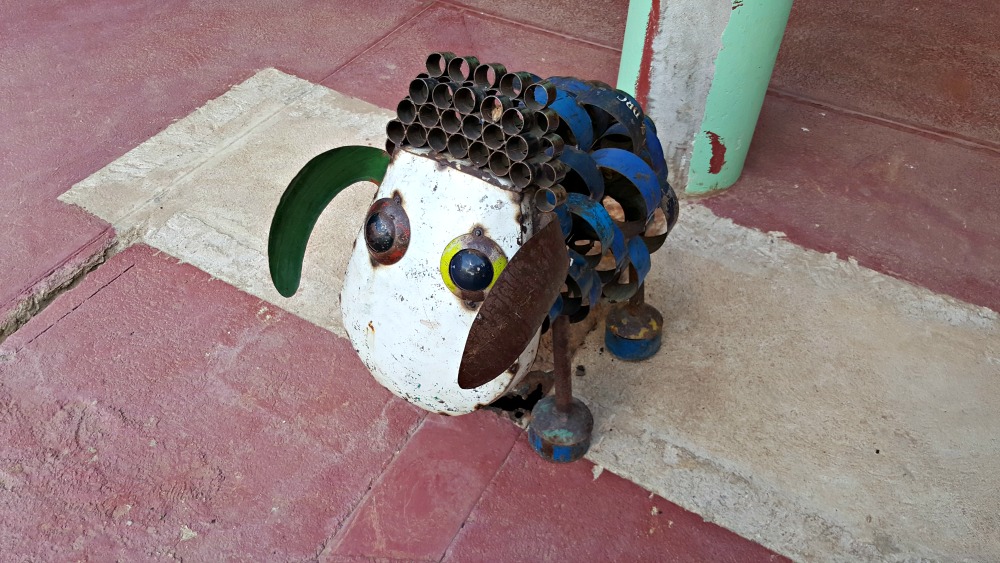
This cute little fellow was in the beer garden of the North Gregory Hotel.
We were up the next morning early for a stroll around town. First stop was Arno’s Wall, a work of art and architecture by local identity and opal miner Arno Grotjahn. It has all sorts of things embedded in it, including a kitchen sink.
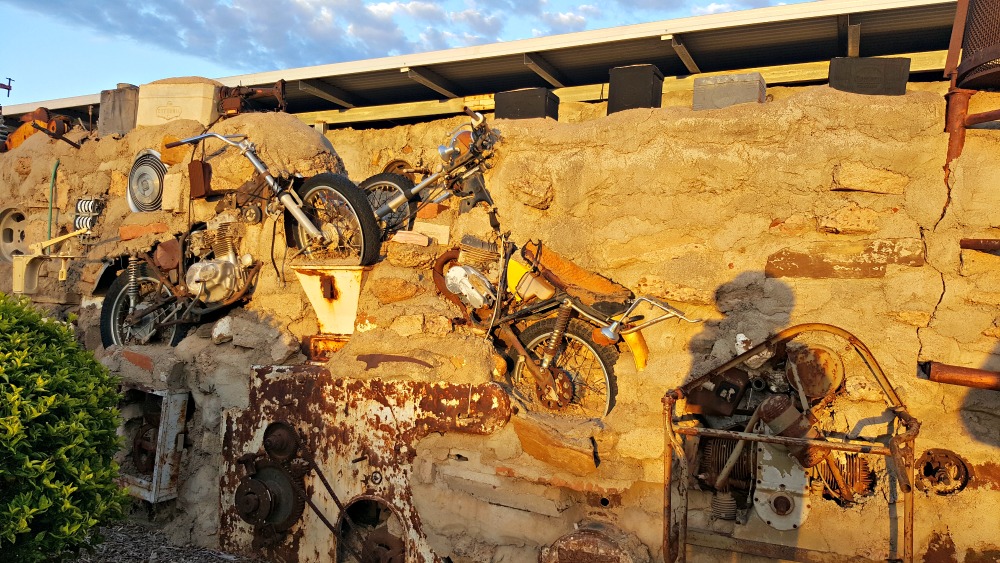
Sunrise hitting some motorbikes embedded in Arno’s Wall.
It was so quiet in Winton that morning, there were brolgas wandering the street.

Brolgas in Winton
Winton town centre features lovely whimsical artwork, wonderful sculptures and commemorative statues. They even have cool dinosaur themed bin covers. Such a nice place to wander around, full of humour and history.

One of the cute pieces of art in Winton’s main street.

Love these dinosaur foot wheelie bin covers.

Banjo Parterson and Waltzing Matilda commemorative statue.

This horse drawn wagon carried the last load of wool to the Winton rail head in 1936. The wagon could carry a load of 9 tonnes when yoked with 19 horses.

The historic Corfield and Fitzmaurice building in Winton’s main street. There’s a museum inside and a shop selling local hand-made crafts. I bought a gorgeous bracelet from there.

This lovely statue is a tribute to Banjo Paterson and to the many swagmen who lie in unmarked graves throughout the country.
There’s nothing so dry as outback Aussie humour and the Tattersalls Hotel outdid itself with these quotes they’d hung on the outside walls.


From Winton we took a drive 110kms south to Lark Quarry and the Dinosaur Stampede National Monument, which was seriously cool. There’s something about seeing 95 million-year-old dinosaur tracks that brings out the excited kid in me.
I love how science has determined that, all that time ago, hundreds of small dinosaurs were wandering near the edge of a lake when a large, meat-eating theropod attacked. Blocked by the lake, the little dinosaurs had nowhere to go, and in a mad panic were forced to run like crazy past the predator to safety. Even more exciting, the event was preserved in the mud and then turned to stone for us to see today.
Though occasionally rough, the drive to Lark Quarry was enjoyable too. Fantastic landscape and just look at that sky!
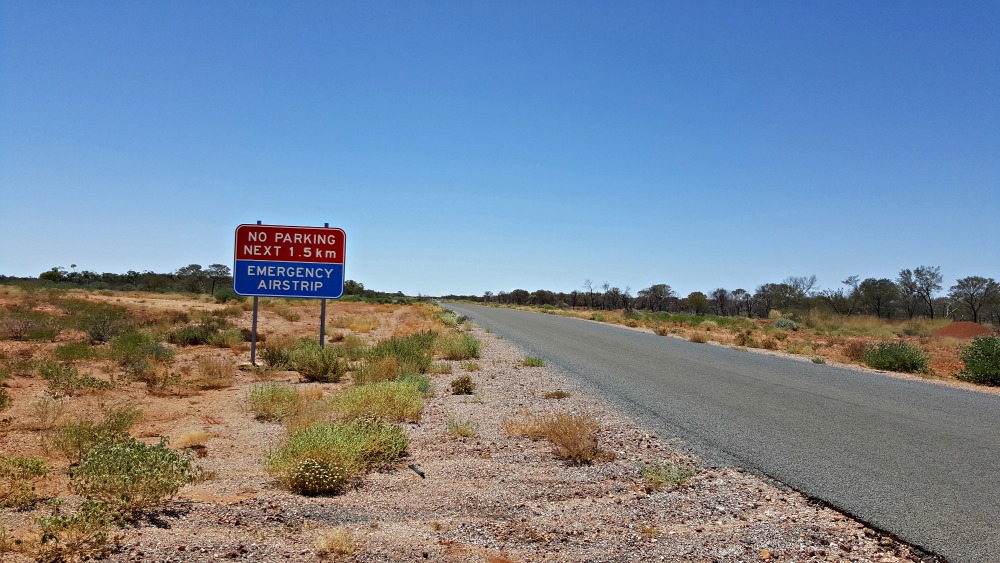
This section of road in the middle of nowhere is designated no stopping so emergency aircraft like the Flying Doctor can land.

Arriving at Lark Quarry
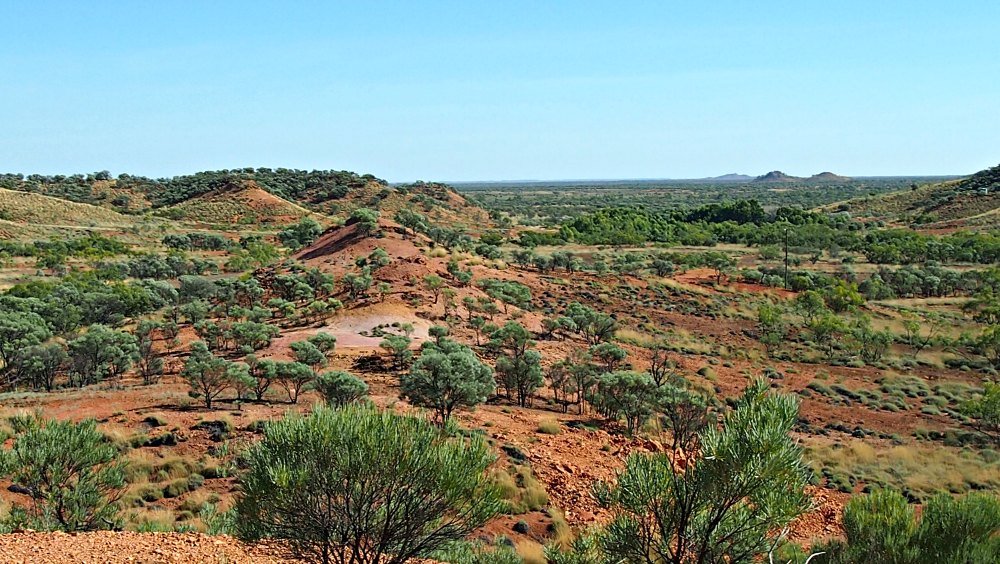
The scenery around Lark Quarry was stunning. The colours are incredible. So vivid they almost look created instead of natural.
Below you can see some of the footprints, preserved under cover (a necessity, not just to protect them from the elements but from people who have damaged and/or tried to nick them over the years). The largest of the theropod prints is 64cm, which extrapolates into a predator approximately 2.5 metres tall at the hips. The other dinosaurs ranged from chicken sized to half the size of an emu. Just enough for a nice snack.

Dinosaur footprints! And the only known preserved dinosaur stampede in the world. Fantastic.
From Lark Quarry I made Jim take a detour to Old Cork Station. The road deteriorated so badly we thought we’d taken a wrong turn, it wasn’t on the GPS and don’t even think about internet access. Earlier there’d been another track heading off in a different direction, so we u-turned back to try that, only for it to dead end at a gypsum quarry. So around we went again… with much swearing and muttering from the driver about people who get excited and soppy about things that are nothing but lines in a forgotten song. But we found it in the end and I ticked Old Cork Station off my bucket list. Jim, however, was completely underwhelmed and still hasn’t let me forget it.
For those of you who have never heard of Old Cork Station, take a listen to Australian folk band Redgum’s “Diamantina Drover“.
I defy you not to feel romantic about it!

The sandstone ruins of Old Cork Station near the Diamantina River, one of the shire’s original properties. Old Cork was first settled in the 1860s and the homestead built in 1880-85.
After Old Cork (yes, there’s still a Cork Station, if you’re wondering – we drove past the ‘new’ homestead on the way) we journeyed back to Winton, where Jim got chatting to a local who’d called into the tourist office for a natter. Apparently the local had been up to Combo Waterhole the day before and it was running, something he’d never seen before.
Naturally, being his father’s son, Jim decided to take a drive cos, you know, we clearly hadn’t done enough already that day. *rolls eyes*
Combo Waterhole is iconic in Australian bush culture. It lies 132km north-west of Winton off the Landsborough Highway and is believed to be the setting of, or at least the inspiration for, AB (Banjo) Paterson’s Waltzing Matilda which he wrote while visiting Dagworth Station (which Combo Waterhole was once a part of) in 1895.
You know how it goes…
Once a jolly swagman camped by a billabong
Under the shade of a coolibah tree,
And he sang as he watched and waited till his billy boiled:
“Who’ll come a-waltzing Matilda, with me?”
Combo is, so the story goes, the billabong in question. It’s also of importance to Jim’s family because across the other side of the waterhole is a Cobb and Co staging post where Jim’s great grandfather worked and where his great-uncle Les was born.

Sign indicating the turn-off to Combo Waterhole. The waterhole is on the horizon somewhere.

Standing at Combo Waterhole, which is actually a series of waterholes. As you can see it was flowing quite quickly so we didn’t try to cross to visit the Cobb and Co post.
The local also told us that if we could catch sunset at the 4-mile windmill (four miles from Winton, funnily enough) it’d make for some spectacular photos. We did and they were!

The peace of watching this sunset was quite incredible.
The following day we headed 24 kms out of Winton to the Australian Age of Dinosaurs, which was also excellent. The museum holds the world’s largest collection of unique Australian dinosaur fossils.

Perfectly normal thing to do, stick your head in a dinsosaur’s mouth. This is “Banjo”.

Volunteers working to clean a dinosaur bone in the lab.
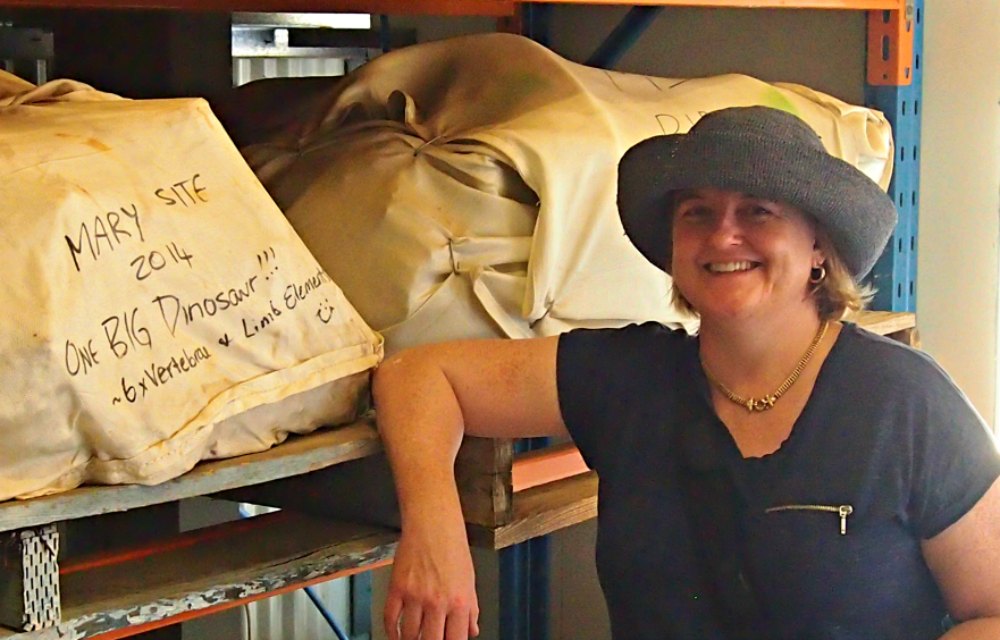
Love what’s written on the outside of this preserved pack of bones: “One BIG Dinosaur!!!”
Close to Winton is the Bladensburg National Park, which was once Bladensburg Station but was designated a National Park in 1994. There’s a half day drive you can do around it called the Route of the River Gum. We had a four-wheel-drive so we did it, and had a great time.

Kangaroos sheltering from the heat in one of the claypans at Bladensburg. The claypans allow water to run off so freely that it only takes half an inch of rain to fill the waterholes. Drovers used to follow the storms, knowing that even a small one would produce enough runoff to provide water for themselves and their livestock.

Richard Cragg’s lonely grave in Bladensburg. Cragg was a mail contractor who died in December 1888 aged 46, apparently from “poison.”

The 1894 shearer’s strike memorial. It was here that 500 shearers camped during the strike of 1891 and 1894, when Winton was under martial law. It’s also of historical political significance as these events played a role in the founding of the Australian Labour Party.

Engine Hole, a waterhole in the park. Even a simple ham, cheese and tomato sandwich tastes like gourmet food when you eat it somewhere like this.
Bladensburg Homestead and shearing shed is open for visitors. This shed was built in the 1960s after the original shearing burnt down, and has only 6 stands, reflecting stocking rates of the time. Sheep numbers on Bladnesburg ranged from 30,000 in 1915, to 600,000 (!!) in the 1920s, declining to 14,000 in the 1950s.
The change in numbers is amazing. In 1965 in Queensland’s Flinders Shire alone there were nearly 1.3 million sheep. By 2006 there were only 156,000. Cattle are now the primary stock that’s run.
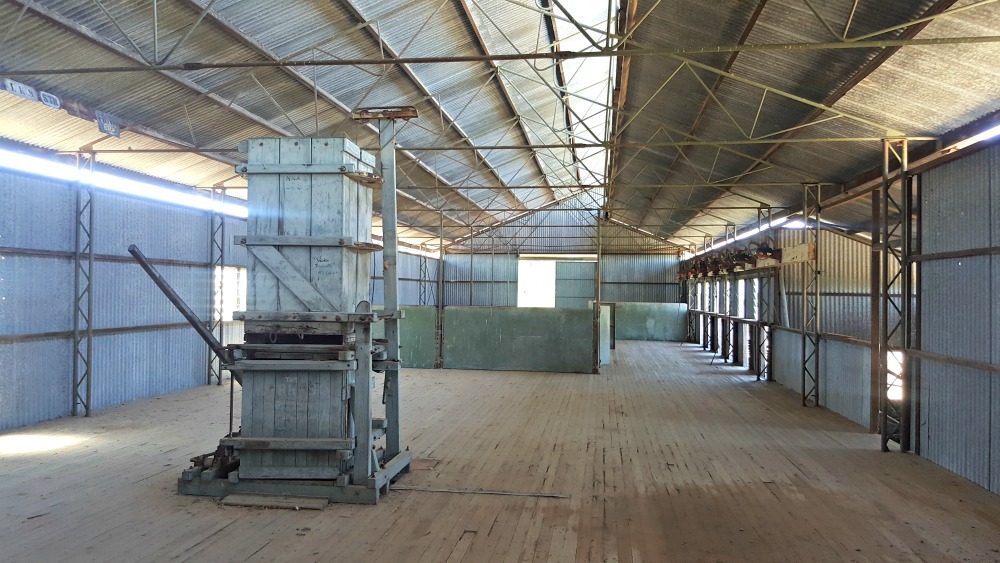
Bladenburg’s old shearing shed.
Before we left Winton, I had to play on its musical fence. It made me laugh, even if Jim thought I was a twit.

Can’t say my efforts on the musical fence were very tuneful.

I did feel, however, that I played the drums quite marvellously.
We called into Hughenden on the trip back and had a terrific time visiting the museum and checking out the sculptures.

Mutt the Muttaburrasaurus, a fibreglass replica. These dinosaurs grew up to 7 metres in length and were 2.2 metres at the hip. Behind, the gorgeous old Grand Hotel, sadly closed.

This windmill sculpture/rotunda in Hughenden’s main street was erected in 2001 to celebrate the centenary of Federation and features two 20 foot blade windmills. It’s practical as well as interesting and, thanks to interpretive panels inside, educational. Danny from Santa and the Saddler would have loved it!

One of the dinosaur metalwork sculptures that dot the centre of town.

Another metalwork sculpture in Hughenden. Clever!
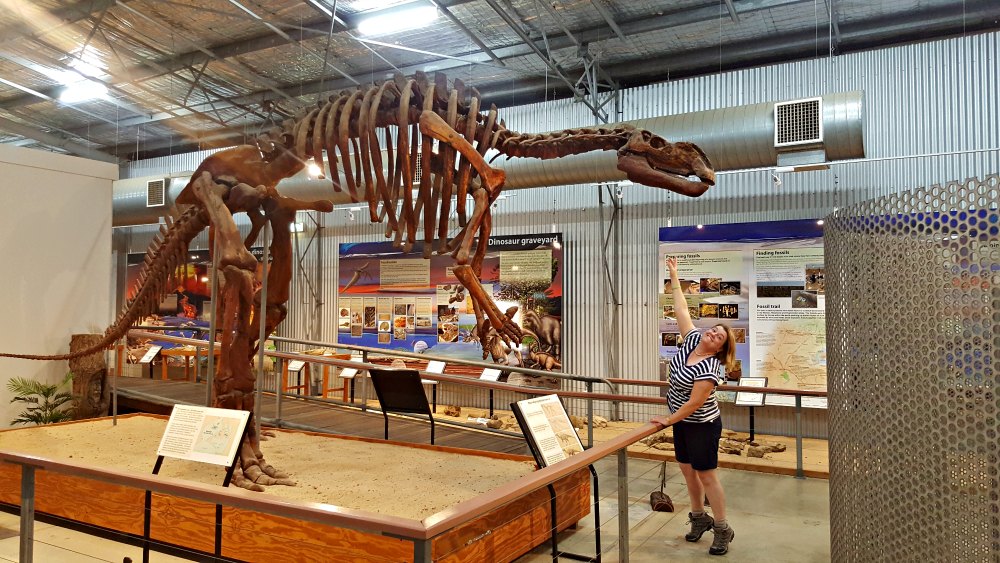
Hughie, the 7 metre tall muttaburrasaurus in the Flinders Discovery Centre.
Danny, windmill engineer and hero of my rural romance Santa and the Saddler, would have gone nuts over this gigantic Comet windmill in Hughenden.
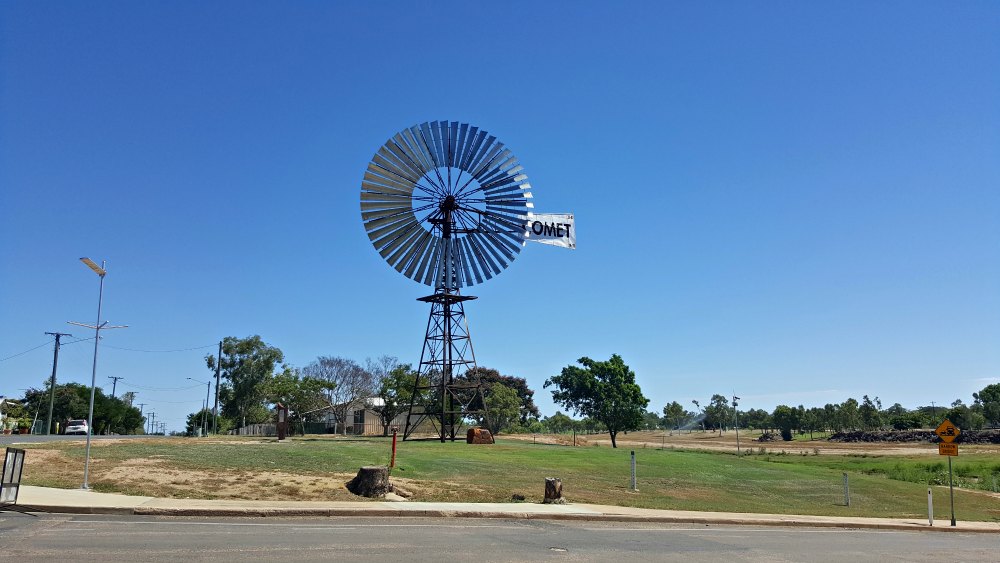
The Wirilla Station windmill, now in Hughenden, stands on the banks of the Flinders River and is one of only fifteen 35 foot mills ever manufactured. This one is number 11 and it could pump a million litres of water a day with an average wind. Danny would have wet his pants!
From there we drove back to Charters Towers, a famed gold rush town, where we enjoyed a picnic lunch at Centenary Park and this commemorative sculpture.
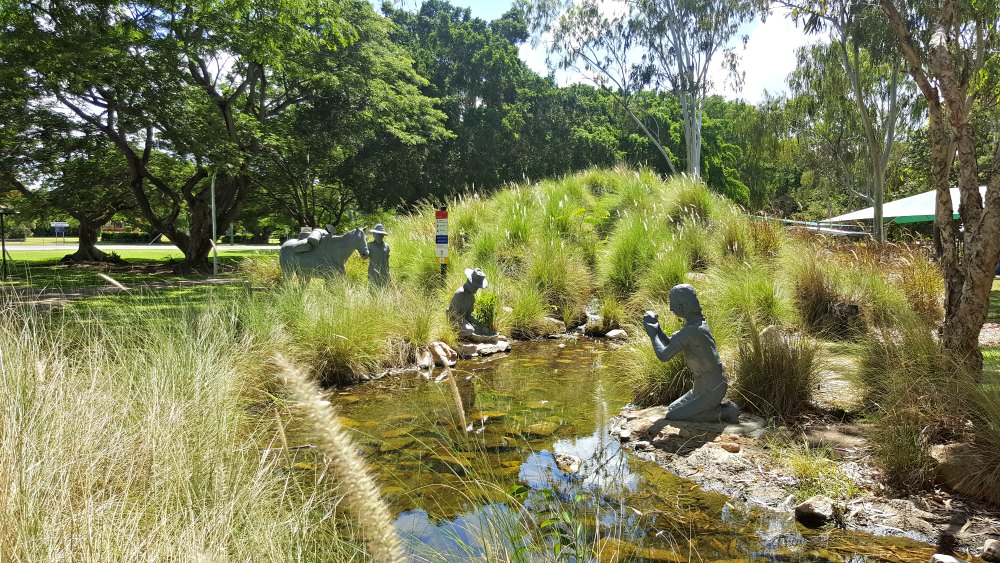
The Gold Discovery Monument by Queensland artist Hugh Anderson
I was sad to leave the area. We’d had such a great adventure, experiencing outback Queensland and visiting locations so iconic and significant in Australia’s history.
Next time we’re up in Townsville with time to spare, I’m hoping to take a (longish) drive north-west to the Undara Volcanic National Park to check out the lava tubes. My parents-in-law tell me they’re spectacular.
Hope you enjoyed this post from This Writing Life. Don’t expect too many other adventures for a while. No time for fun in the Hein house, it’s book writing time and I have an idea for a beeeoooooty!


Comments are closed